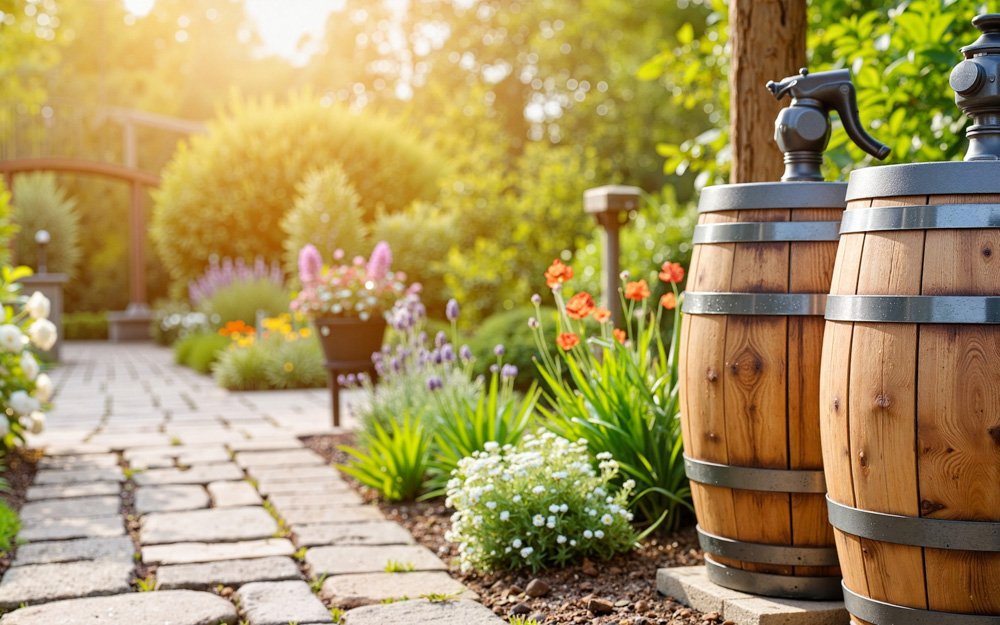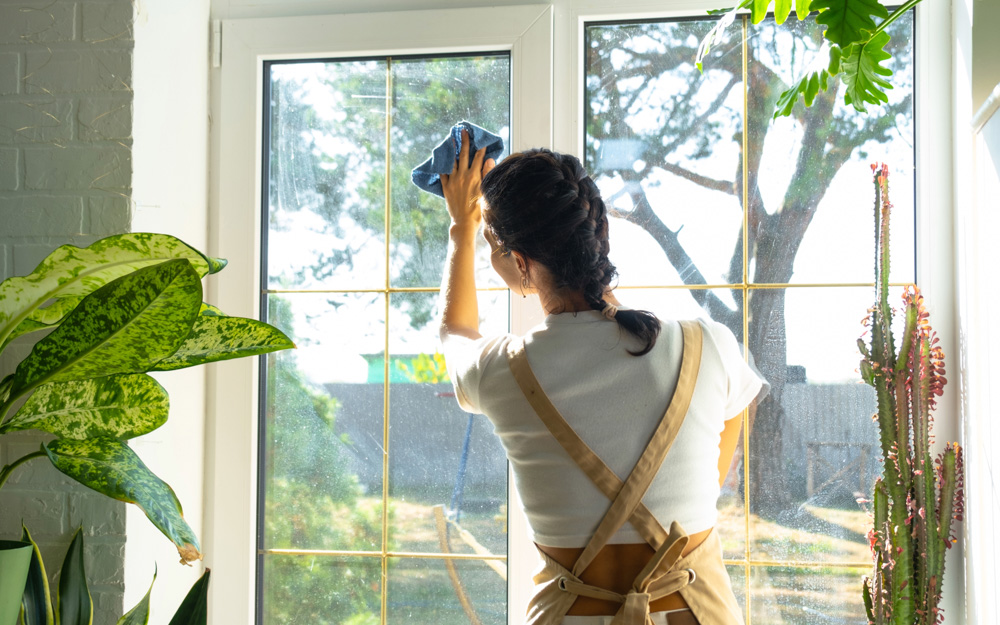Tips to Create a More Sustainable Lifestyle This Spring
Spring is upon us, and many see this change in season as a fresh start. With the arrival of May flowers, why not adopt some more green practices into your home and routine? In this article, we’ve curated a number of spring sustainability ideas for you. Whether you incorporate just a few, or aim for the sky, we promise you won’t regret creating a more sustainable spring!

eco-friendly habits for the yard
This list of green living tips for the spring wouldn’t be complete without some ideas about how to create a more eco-friendly outdoor space. Although we don’t believe that sustainability is seasonal, spring is when you can make the biggest impact in the yard.
Start composting at home
First, before we talk about composting, let’s mention the spring cleanup that happens in the yard. I know it’s tempting to get rid of all those dead leaves as soon as the snow melts, but I urge you to leave them for a while. There are many good reasons to keep that fallen foliage around for a while. The most important being that those leaves have provided many insects a place to overwinter, including pollinators like butterflies, moths, and native bees. If you remove or mulch the leaves too early, you’ll be reducing the beneficial insects in your yard and the neighbourhood.
Now, once it’s time to mulch or collect those leaves, feel free to add them to your backyard compost or have them taken away by your city’s yard waste service (if provided). It’s important not to add them to the regular garbage collection – where they will be sent to the landfill to decompose anaerobically (without oxygen) and produce methane.
Don’t yet have a compost system set up? Not to worry! Hop over to our article “How To Compost Like a Pro” to help you get started, or check out Lomi – a countertop food waste decomposer that creates nutrient rich soil in hours.
Plant a Garden
There are so many reasons you should plant a garden at home this year!
- Access to fresh, organic, and delicious homegrown vegetables, herbs, and fruits, steps outside your door.
- Growing your own will save you money at the grocery store or farmer’s market.
- You can bring fresh produce from your garden as a gift to the host when attending dinner parties or other events.
- Teaching your kids to garden allows you to spend quality time with them while they learn a valuable skill.
- Gardens help prevent storm water runoff and soil erosion.
- It will keep you healthier in general – according to the National Library of Medicine, “exposure to plants and green space, and particularly to gardening, is beneficial to mental and physical health.”
You can find an abundance of organic gardening tips online, including for flower and perennial gardens that will attract pollinators to your yard. If you want to make your outdoor space even more sustainable, you might consider replacing your grass with more eco-friendly options.
Save water
If you want to maximize your sustainability in the yard, conserving water should be a priority. Planting drought resistant grasses, shrubs, and perennials will allow you to water less frequently. Adding plants that are native to your area and climate means that they will adapt and need less care than those not meant to thrive there. Careful placement of each kind of plant according to its soil and sun vs. shade needs will help you avoid excess watering as well. Investing in a rain barrel or two can provide enough water for a mid-sized garden, eliminating the need for a sprinkler or water hose.
spring cleaning sustainability

When you come from a place that has a severe winter like I do, the warmer weather and lack of snow allows us to take care of things around the house we aren’t able to in the cold. “Spring cleaning,” otherwise known as a deep clean or decluttering, is therefore very common in Canada. Here are a few ways you can incorporate some eco-friendly habits into this annual tradition.
choose natural cleaning alternatives
A really easy and cost-effective way to be more eco-friendly this spring is to use natural, chemical-free cleaners. A study conducted by Chemosphere found that “the use of cleaning products results in inhalation exposure to numerous volatile organic compounds” that can adversely affect human health. One alternative is to make your own your own cleaners, or use ones that are EWG certified and fragrance-free. Two brands that we like are Made Safe certified Meliora, and Canadian company The Bare Home (use code SUCCESSFULLYSUSTAINABLE for 10% off).
Decluttering responsibly
We all have that collection of “stuff” that we put aside over the year to get rid of. But it can be difficult to determine the most sustainable way to do so. Before putting it in the trash (!), or simply driving it to the nearest thrift store for donation, here are some other options:
- Post the items for free on an online marketplace or giveaway group for your neighbourhood. A quick search online or social media will likely turn up many options.
- Ask friends or family if anyone would be interested in the items – you might be surprised!
- If you’re disposing of the item because it’s torn or broken, consider learning how to fix it or having it repaired.
- Try to think of ways the item might be repurposed or up-cycled into something else that could serve a purpose in your home.
- Organize a swap party with friends where you all bring a box or two of your unwanted items.
- If you really want to donate the items in bulk, do a little research about which operation in your city will ensure the items are given to people in need, and not sold for a profit.
environmental lifestyle changes
With warmer weather comes more opportunity to commute more sustainably. Why not take advantage and adopt a more climate-friendly routine?

Sustainable Transport Tips for a Sustainable Spring
The arrival of warmer weather inspires many of us to spend more time outdoors. Why not let that be your incentive to try occasionally cycling or walking to work? This may seem like a big or intimidating step in your sustainable journey, but there are ways to start small with this one. Take a look at our article “Environmentally Friendly Work Commute – Become a Green Commuter” for tips and inspiration. As someone who often ran or biked to work as a teacher, I can tell you that starting your day with some physical activity will leave you more energized and productive!
Not sure you’re ready or willing to sweat your way to work? Give one of the sustainable transport options in your city a try. Download your favourite podcast or bring along a book and enjoy having someone else drive you around! Alternatively, perhaps you could start carpooling with another coworker or two to make your commute more eco-friendly.
Don’t stop there! You might find that once you’ve incorporated your bike, feet, or the bus into your work routine that you’ll even start getting around this way to run errands or visit friends.
reduce your carbon footprint
The following sustainable lifestyle tips will not only help you reduce your carbon footprint, but will save you money when it comes to the monthly bills!
Reduce your energy consumption
Adopting small energy-efficient habits, like unplugging when not in use, turning off unnecessary lights, and adjusting the thermostat accordingly, can add up to big changes. Find a plethora of ideas to decrease your energy use here in our “Ultimate Guide: Sustainable Home.”

Consider renewable energy
If you’re serious about making some sustainable home updates, investing in renewable energy like geothermal or solar panels can make the biggest impact on your footprint. Another eco-friendly home improvement you may consider would be replacing old appliances at their end of life with more energy efficient ones. Have your furnace and air conditioning serviced and ducts cleaned regularly to ensure your home is heated and cooled as efficiently as possible.
Embrace a low waste lifestyle
Our most important piece of advice when it comes to how to live sustainably is always to reduce your consumption. It’s no secret that the more stuff we buy, the more waste (in all aspects) is created. Mindful consumption comes in many forms. Start with the practice below that seems most attainable for you to get the ball rolling.
Avoiding Food waste This sustainable spring
The USDA has found that in the U.S., food waste is estimated at an astronomical 30-40 percent of the food supply. Granted, this includes commercial waste as well as household, but that doesn’t mean we can’t do better at home. Now that you have a sustainable organic garden of your own, perhaps some of your food waste will be mitigated already. Here are a few other ways you can put a halt to letting food spoil unnecessarily:
- Learn to love leftovers, or portion them out and freeze them for future school or work lunches.
- Take an inventory before you go shopping to make sure you don’t buy something you don’t truly need.
- Rotate your old stock to the front of the fridge or cupboard when unpacking groceries so you use them first, before they expire.
- Every once in a while, take note of what needs to be used in the next day or so and look up a new recipe or two that incorporate those ingredients.
- The next time something does go bad before you get around to using it, try to remember for the next time so you don’t overbuy that item again.
- If there’s a local market nearby, make a habit of going every few days to pick up some local produce and other perishables rather than doing one big shop every week or so.
Welcome Plastic-free living
Most of us have quite seamlessly transitioned into reusable shopping bags, but why stop there? Next time you need to replace something that is typically made of plastic, check out some alternatives like wood, bamboo, or metal first. Everything from tooth brushes, combs, cooking utensils, and toilet brushes are now made from more sustainable materials.
Start saying no to single-use plastics. Opt for loose produce at the market and carry a mesh bag to use instead of those flimsy throwaway plastic ones. Silicone satchels can be used in place of Ziploc bags, beeswax wraps or reusable containers take the place of saran wrap, and so on. There was life before plastic and in some cases, steps backward actually means progress for the environment.
Minimalism for beginners
Fully embracing a life of minimalism is one of the most sustainable steps you can make. Curbing consumption impacts not only your carbon footprint, but your water footprint as well. The expression “the most sustainable item is the one you already own” has never been more meaningful. When considering a purchase, ask yourself “Do I really need this? Will it truly add value to my life?” Before you discard an item, consider repairing or repurposing it first. Minimalism is a mindset that can be adopted over time – to learn more about how to do this, read our article here.

Practice ethical consumption
A sustainable lifestyle isn’t just about making eco-conscious choices. It’s important that we think about the people behind our purchases as well. An organic cotton t-shirt may be more environmentally friendly than a polyester one, but if the workers along the supply chain aren’t paid fairly or treated well, it’s not really a sustainable item, is it? Do your research before you support a brand – looking for transparency in their supply chain and sustainability certifications is a good start.
Activities for sustainable living this spring
After a long winter, everyone loves reconnecting with nature in the spring. Make an effort this year to extend that excitement and spend more time outdoors all year round. If it’s a lack of ideas that has you retreating back indoors we’ve got plenty green spring activities to share!

- Go on a picnic in your favourite park. Bonus if you walk there rather than drive!
- Take a hike and immerse yourself in nature.
- Practice some forest bathing – a Japanese form of “eco-therapy”
- Hit the water in a kayak, canoe, or paddle board.
- Take a stroll in a new neighbourhood and have a snack or drink on a patio.
- Visit a local farmer or maker’s market and support the local economy.
- Go for a bike ride as a family, with a friend, or on a date.
- Escape the city and go camping! Not a fan of tents? There are so many glamping options out there now to try.
- Spend some time with your new garden.
- Hit that to-do list that you’ve been avoiding all winter long.
- Organize a pick-up game of soccer, ultimate frisbee, or other activity with some friends.
- Rainy day? Watch a nature documentary or do a spring-themed DIY eco-craft.
- Read on your porch, balcony, or in your hammock. Or bring a blanket to the park and read there! Check out our book recommendations here.
- Practice your photography skills and snap some shots of all the new buds and flowers emerging.
- Head to the nearest ice cream shop that just opened for the season.
- Get involved for a more sustainable spring – find a local charity where you can volunteer, or organize or attend a local neighbourhood cleanup.
Final thoughts for a Sustainable Lifestyle This Spring
Spring is the perfect time to make some environmental lifestyle changes. Making more eco-conscious choices not only protects our planet for future generations, but it helps us create a more meaningful, simple life. We hope that some of our spring sustainability ideas were helpful in your eco-friendly journey!

All products recommended to you on Successfully Sustainable are independently researched in depth. To avoid waste and lead a minimal lifestyle, we test products only when required. This post contains affiliate links. If you buy something through our links, we may earn a small commission. Learn more about this here.





